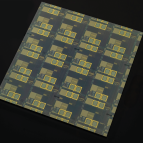ALCOR Radome Replacement

The Advanced Research Projects Agency (ARPA) Lincoln C-band Observables Radar (ALCOR) — the first long-range imaging radar — began operations on Kwajalein Atoll in 1970. ALCOR is encased by a large dome-shaped structure (radome) that protects the space surveillance sensor from the harsh tropical environment on the island of Roi-Namur. Containing more than 500 panels, the aluminum radome was designed to keep the radar dry and withstand winds of up to 150 mph.
By 2017, ALCOR’s radome was more than 20 years past its life expectancy, and the environment had taken a significant toll. The formerly waterproof membrane was leaking, and multiple radome panels had sustained rips and were patched with duct tape.
The Laboratory worked with the U.S. Army and its contractors to purchase a new metal space frame radome in 2018. In 2019, Radome Services came onsite to replace the radome. They removed the top cap of the radome as a large single piece and then disassembled this cap at ground level. Following the cap removal, they took off each of the panels individually and dismantled the radome all the way down to the base ring, which connects the radome to the concrete foundation. Radome Services installed a new base ring on top of the old one and built up the new radome panel by panel until it was about 80% complete. To finish the install, they assembled the new cap directly on a crane and lifted it into place — a process that took several days as the team waited for the wind speed to decrease.
The new radome, which staff expect will keep the radar dry for at least 20 years, uses a semi-random panel configuration and a water-repellent coating that minimizes losses at the C-band portion of the electromagnetic spectrum. The radome replacement is among several upgrades and modernization efforts that the Laboratory is leading to keep ALCOR serving the nation for many years to come.





